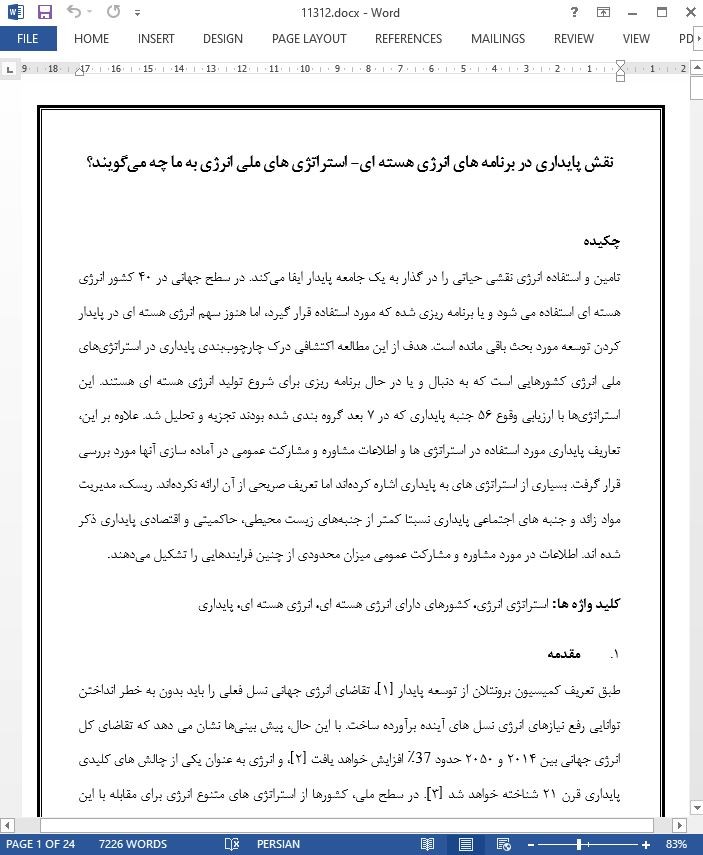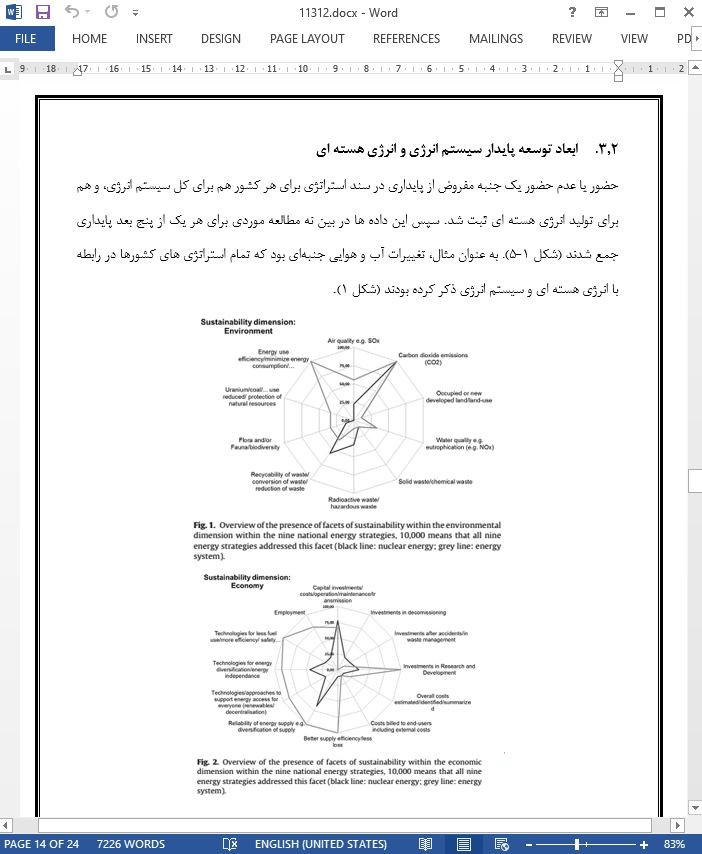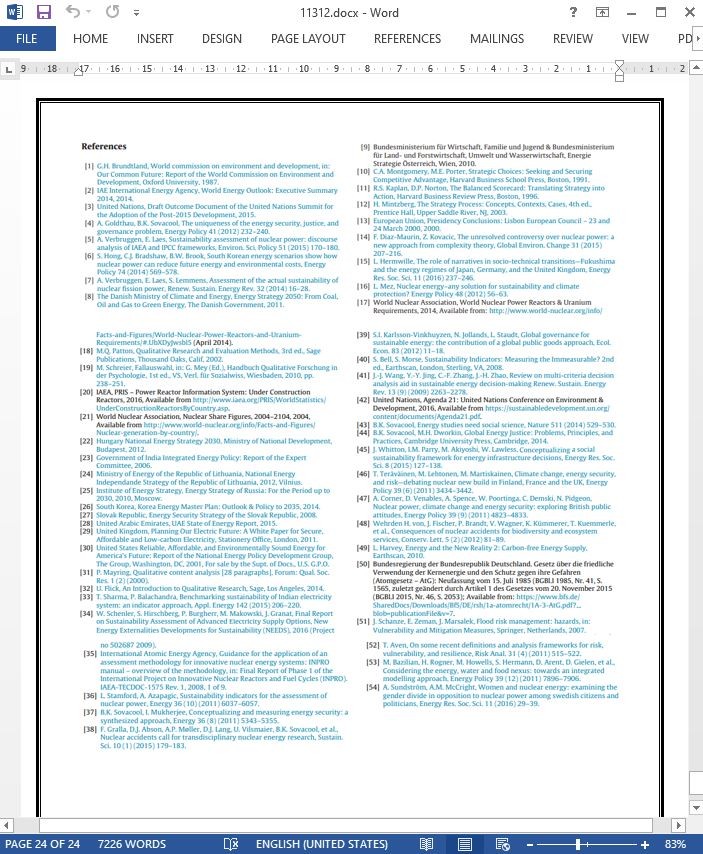
نقش پایداری در برنامه های انرژی هسته ای- استراتژی های ملی انرژی به ما چه می گویند؟
چکیده
تامین و استفاده انرژی نقشی حیاتی را در گذار به یک جامعه پایدار ایفا می کند. در سطح جهانی در 40 کشور انرژی هسته ای استفاده می شود و یا برنامه ریزی شده که مورد استفاده قرار گیرد، اما هنوز سهم انرژی هسته ای در پایدار کردن توسعه مورد بحث باقی مانده است. هدف از این مطالعه اکتشافی درک چارچوب بندی پایداری در استراتژی های ملی انرژی کشورهایی است که به دنبال و یا در حال برنامه ریزی برای شروع تولید انرژی هسته ای هستند. این استراتژی ها با ارزیابی وقوع 56 جنبه پایداری که در 7 بعد گروه بندی شده بودند تجزیه و تحلیل شد. علاوه بر این، تعاریف پایداری مورد استفاده در استراتژی ها و اطلاعات مشاوره و مشارکت عمومی در آماده سازی آنها مورد بررسی قرار گرفت. بسیاری از استراتژی های به پایداری اشاره کرده اند اما تعریف صریحی از آن ارائه نکرده اند. ریسک، مدیریت مواد زائد و جنبه های اجتماعی پایداری نسبتا کمتر از جنبه های زیست محیطی، حاکمیتی و اقتصادی پایداری ذکر شده اند. اطلاعات در مورد مشاوره و مشارکت عمومی میزان محدودی از چنین فرایندهایی را تشکیل می دهند.
1. مقدمه
طبق تعریف کمیسیون برونتلان از توسعه پایدار [1]، تقاضای انرژی جهانی نسل فعلی را باید بدون به خطر انداختن توانایی رفع نیازهای انرژی نسل های آینده برآورده ساخت. با این حال، پیش بینی ها نشان می دهد که تقاضای کل انرژی جهانی بین 2014 و 2050 حدود 37٪ افزایش خواهد یافت [2]، و انرژی به عنوان یکی از چالش های کلیدی پایداری قرن 21 شناخته خواهد شد [3[. در سطح ملی، کشورها از استراتژی های متنوع انرژی برای مقابله با این چالش استفاده می کنند، و اغلب ادعا می کنند که انتقال انرژی پایدار انگیزه اصلی آنها است. با این حال، جنبه های متعدد حاکمیت انرژی [4] با اهداف هنجاری پایداری در تقابل قرار دارند و "جنبه-های به طور واضح تعریف شده از پایداری" برای ارزیابی سیاست انرژی وجود ندارند [5]. از این رو، دولت های مختلف می توانند منابع انرژی مشابه را (از دیدگاه پایداری) بسیار متفاوت ارزیابی کنند. به عنوان مثال، انرژی هسته ای یک گزینه پایدار در کره جنوبی در نظر گرفته می شود [6]، اما از استراتژی های انرژی پایدار [7] در کشورهایی مانند دانمارک [8] و یا اتریش [9[ حذف شده است.
5. نتیجه گیری
اسناد سیاستی مانند استراتژی های انرژی مورد تجزیه و تحلیل می توانند نقش مهمی را به عنوان ورودی برای تصمیم گیری و اجرای اقدامات در سیاست انرژی بازی کنند. در اینجا، تجزیه و تحلیل اسناد مشخص کرد که تا چه حد، ابعاد مختلف پایداری در چنین اسناد سیاستی ذکر شده است. تجزیه و تحلیل ما از استراتژی های نه کشور هسته ای نشان داد که تعاریف صریح و روشن از پایداری در رابطه با سیاست های انرژی وجود ندارد. به نوبه خود این استراتژی های انرژی دیدگاه متمرکزی را نشان دادند که تعدادی از وجوه پایداری، مانند مسائل مربوط به ابعاد پایداری اجتماعی و ریسک را کمتر از حد نشان دادند. تحقیقات بیشتر در مورد دخالت وزارتخانه های متعدد و فعالان اجتماعی در ایجاد استراتژی های انرژی مورد نیاز است، و دیدگاه هایی که ارائه می دهند می تواند به اطمینان از نیاز به تعریف پایداری به منظور جلوگیری از سوء تفاهم، درک اولویت ها و مقابله با مبادله کمک کند.
Abstract
Energy supply and use play vital roles in transition towards a sustainable society. Nuclear energy is used or planned to be used in 40 countries globally, yet the contribution of nuclear energy to sustainable development remains an area of contention. The purpose of this exploratory study is to understand the framing of sustainability within national energy strategies of countries pursuing or planning to start nuclear energy production. The strategies were analyzed by assessing the occurrence of 56 facets of sustainability grouped into 7 dimensions. In addition, the definitions of sustainability used in the strategies and the information on consultation and public participation in their preparation was reviewed. Most strategies mentioned sustainability but did not provide its explicit definition. Risk, waste management and social aspects of sustainability were mentioned relatively less frequently than to environmental, governance and economic aspects of sustainability. The information on consultation and public participation portrayed a limited extent of such processes.
1. Introduction
Following the Brundtland commission’s definition of sustainable development [1], the global energy demands of the current generation should be satisfied without compromising the ability of future generations to meet their energy needs. Yet, projections suggest that the aggregate global energy demand will increase by approximately 37% between 2014 and 2050 [2], with energy being identified as one of the key sustainability challenges of the 21st century [3]. At the national level, countries use diverse energy strategies to tackle this challenge, often claiming sustainable energy transitions to be their main motivation. However, multiple aspects of energy governance [4] intersect with the normative goals of sustainability and “clearly defined facets of sustainability” for assessing energy policy are lacking [5]. Hence, different governments can appraise the same energy sources very differently (from a sustainability perspective). For example, nuclear energy is considered a sustainable option in South Korea [6], but is excluded from sustainable energy strategies [7] in countries like Denmark [8] or Austria [9].
5. Conclusions
Policy documents like the analyzed energy strategies can play a pivotal role as input for decision-making and implementation of measures within energy policy. Here, a document analysis has identified the extentto which, different dimensions of sustainability are mentioned within such policy documents. Our analyses of energy strategies of nine nuclear countries revealed a lack of explicit definitions of sustainability in relation to energy polices. In turn these energy strategies showed a focused perspective that underrepresented some facets of sustainability, such as issues within the social and risk sustainability dimensions. Further research is required on the involvement of multiple ministries and societal actors in building energy strategies, and the perspectives that they bring, may help to ensure the need for a sustainability definition in order to avoid misunderstandings, understand priorities and counteract trade-offs.
چکیده
1. مقدمه
2. مواد و روش ها
2.1. نمونه موردی
2.2. تجزیه و تحلیل محتوا بر اساس جنبه های پایداری
2.3. دامنه و محدودیت های مطالعه
3. نتایج
3.1. نه استراتژی انرژی - تعریف پایداری، اطلاعات در مورد مشارکت و پایداری مربوط به انرژی هسته ای
3.2. ابعاد توسعه پایدار سیستم انرژی و انرژی هسته ای
4. بحث
4.1. استراتژی های انرژی کشورهای هسته ای و پایداری
5. نتیجه گیری
Abstract
1. Introduction
2. Methods
2.1. Case sampling
2.2. Content analysis based on facets of sustainability
2.3. Scope and limitations of the study
3. Results
3.1. Nine energy strategies – definition of sustainability, information on involvement and sustainability related to nuclear energy
3.2. Sustainability dimensions of the energy system and nuclear energy
4. Discussion
4.1. Energy strategies of nuclear countries and sustainability
5. Conclusions
- ترجمه فارسی مقاله با فرمت ورد (word) با قابلیت ویرایش، بدون آرم سایت ای ترجمه
- ترجمه فارسی مقاله با فرمت pdf، بدون آرم سایت ای ترجمه



